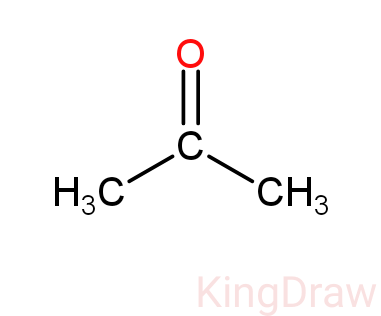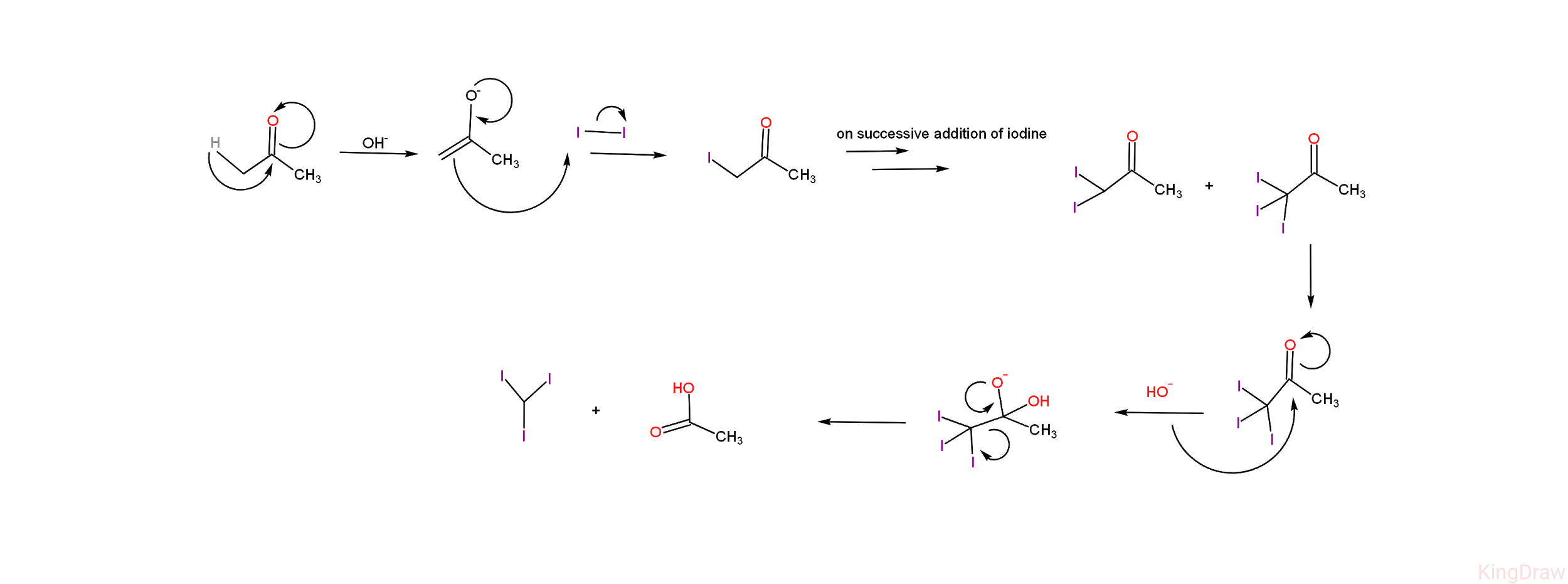
Which of the following compounds is not formed in the iodoform reaction of acetone?
(A)
(B)
(C)
(D)
Answer
156.3k+ views
Hint: Iodoform reaction of acetone will lead to the products - acetic acid (
Complete Step by Step Solution:
-Structure of acetone is given below:

-Iodoform reaction is used to identify the presence of carbonyl compounds in compounds.
-Here in the iodoform reaction of acetone, the acetone will be reacted by
-When we look at the mechanism of this reaction, we can see many intermediates formed in between.
-Given below is the diagrammatic representation of the mechanism of iodoform reaction of acetone. -From the mechanism, we can see that the iodoform reaction of acetone leads to the products - iodoform (
-From the mechanism, we can see that the iodoform reaction of acetone leads to the products - iodoform (
-Apart from the final products, there are certain stable intermediates formed in the reaction - i.e, on addition of iodine on acetate ion, it leads to the formation of 1-iodoacetic acid (
-So, these compounds
-In the question, it has been asked which among the options are not formed in the iodoform reaction of acetone and that compound is Option (B)
Therefore, the correct answer here is Option (B)
Note: Iodoform reaction occurs when there is an
Complete Step by Step Solution:
-Structure of acetone is given below:

-Iodoform reaction is used to identify the presence of carbonyl compounds in compounds.
-Here in the iodoform reaction of acetone, the acetone will be reacted by
-When we look at the mechanism of this reaction, we can see many intermediates formed in between.
-Given below is the diagrammatic representation of the mechanism of iodoform reaction of acetone.
 -From the mechanism, we can see that the iodoform reaction of acetone leads to the products - iodoform (
-From the mechanism, we can see that the iodoform reaction of acetone leads to the products - iodoform (-Apart from the final products, there are certain stable intermediates formed in the reaction - i.e, on addition of iodine on acetate ion, it leads to the formation of 1-iodoacetic acid (
-So, these compounds
-In the question, it has been asked which among the options are not formed in the iodoform reaction of acetone and that compound is Option (B)
Therefore, the correct answer here is Option (B)
Note: Iodoform reaction occurs when there is an
Latest Vedantu courses for you
Grade 8 | CBSE | SCHOOL | English
Vedantu 8 CBSE Pro Course - (2025-26)
School Full course for CBSE students
₹45,300 per year
EMI starts from ₹3,775 per month
Recently Updated Pages
JEE Atomic Structure and Chemical Bonding important Concepts and Tips

JEE Amino Acids and Peptides Important Concepts and Tips for Exam Preparation

Difference Between Alcohol and Phenol

Classification of Drugs Based on Pharmacological Effect, Drug Action

JEE Main Mock Test Series Class 12 Chemistry for FREE

JEE Electricity and Magnetism Important Concepts and Tips for Exam Preparation

Trending doubts
JEE Main 2025 Session 2: Application Form (Out), Exam Dates (Released), Eligibility, & More

JEE Main 2025: Derivation of Equation of Trajectory in Physics

Electric Field Due to Uniformly Charged Ring for JEE Main 2025 - Formula and Derivation

Degree of Dissociation and Its Formula With Solved Example for JEE

Displacement-Time Graph and Velocity-Time Graph for JEE

Geostationary Satellites and Geosynchronous Satellites - JEE Important Topic

Other Pages
JEE Advanced Marks vs Ranks 2025: Understanding Category-wise Qualifying Marks and Previous Year Cut-offs

NCERT Solutions for Class 12 Chemistry Chapter 1 Solutions

NCERT Solutions for Class 12 Chemistry Chapter 2 Electrochemistry

NCERT Solutions for Class 12 Chemistry Chapter 6 Haloalkanes and Haloarenes

Solutions Class 12 Notes: CBSE Chemistry Chapter 1

NCERT Solutions for Class 12 Chemistry Chapter 7 Alcohol Phenol and Ether




